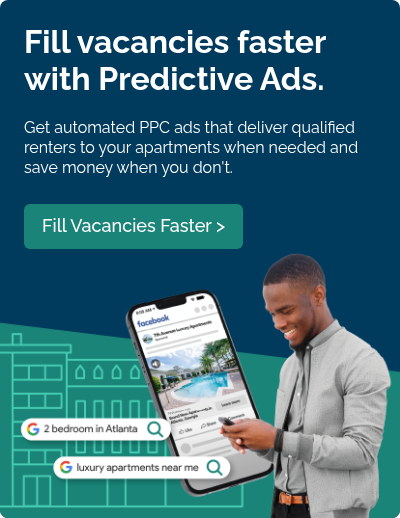A very expensive time clock starts when someone moves out of a unit at one of your apartment communities. From that day forward, your community begins to lose rent revenue until a new resident moves in—which could be weeks and cost your company $100,000+ annually if vacancy durations are uncontrolled.
As you begin to roll out your 2024 marketing strategy for your multifamily properties, this time clock should be at the very top of your mind—specifically, the number of days between when someone moves-out and when you can secure a lease agreement for that vacant unit.
Multifamily marketing isn't just creating awareness and interest in your apartments; it's your best tool for getting leases faster.
Check out these three marketing strategies designed to kickstart your apartment's leasing velocity this year.
Display transparent rent prices and availability on the website.
The quickest way to increase leasing velocity is to establish transparency for rents and availability on your apartment community's website.
Usually, this is possible through built-in integrations with property and revenue management software with the website. Every software is different, so if you need further insight into how to make this happen or would like to learn more about how RentVision can help, set a time to talk with one of our multifamily marketing strategic advisors.
With transparent pricing and availability features on your apartment's website, prospective residents will be more apt to act faster and expedite their leasing journeys, which ultimately helps your leasing velocity.
Of all the different factors playing into a prospective resident's decision to rent from any one particular community, knowing what the monthly rent will be and if there's a current opening in their preferred floorplan always come first.
You need to gain a sense of urgency in the leasing process with real-time availability on your community's website.
When prospects see that you have a select number of units open at any given moment, it may prompt them to act now instead of waiting or finding another competing property they know has an opening.
Meanwhile, lacking pricing on your website is simply detrimental. Having to call or visit you to get pricing creates an unnecessary barrier for apartment shoppers. A majority of apartment marketers know this and do put pricing information online. However, simply having prices shown online doesn't mean it's necessarily helpful or actionable information. We often see apartment websites with confusing pricing information, contributing to struggling occupancy.
With transparent pricing and availability features on your apartment's website, prospective residents will be more apt to act faster and expedite their leasing journeys, which ultimately helps your leasing velocity.
Market apartments on a floorplan-level basis.
There are two specific approaches regarding marketing your apartment communities on a floorplan-level basis: the content on your website, and how to effectively measure overall marketing performance.
Featuring floorplans in your apartment's marketing content is the first step.
The first focuses primarily on the content side; utilizing floorplan-specific pages on your apartment website is best for prospective residents. They know before beginning their search how many bedrooms they need, so when they survey various communities, the first thing they're going to look for is if there's a floorplan available that fits those needs.
A 'Floorplans' page is a standard feature on most apartment websites, but they could be more effective. The typical floorplans page lists the options available and shows a 3-D diagram or another visual layout depicting each. That may be serviceable, but in light of increasing leasing velocity, it is better to have a specific page dedicated to each floorplan.
A 'Floorplans' page is a standard feature on most apartment websites, but they could be more effective. The typical floorplans page lists the options available and shows a 3-D diagram or another visual layout depicting each.
That may be serviceable, but in light of increasing leasing velocity, it is better to have a specific page dedicated to each floorplan on your website.
That way, you can provide the most relevant information about rents, availability, and amenities for individual floorplans. And most critically, you can use those pages to feature visual content like photo galleries and video tours that show the inside of a unit in that specific floorplan.
All that together drives leasing activity because prospective residents can see all the essential information they need about the specific floorplan that interests them on one page.
The second part of marketing your apartments at the floorplan level ties to measurement.
When you have floorplan-specific pages on your website, you can track traffic counts to individual pages and better understand which floorplans prospects look at during different times of the year.
When you start measuring floorplan traffic, you can use that data in your apartment's digital advertising strategy. You can create campaigns for each floorplan, adjust your spending on a unique floorplan's campaign when vacancy hits, and turn off that campaign when that floorplan is full.
With this dynamic approach, you can attack vacancies at their root—the floorplans. When you can stop vacancy there, you're actively preventing it from becoming a community-wide problem, usually solved through price intervention or increased marketing spending.
Focus on leases rather than leads.
Which community below would you say has the better marketing strategy?
Community A (100 Units)
Marketing Sources In Use: 8
Monthly Marketing Costs: $6,000
Average Monthly Leads: 120
Weekly Leasing Velocity: 0.5
Community B (100 Units)
Marketing Sources In Use: 3
Monthly Marketing Costs: $6,000
Average Monthly Leads: 50
Weekly Leasing Velocity: 1.2
Community B is the obvious answer, yet shockingly, its marketing strategy is less popular among multifamily marketers.
Instead, Community A's marketing strategy is the more universally accepted and used strategy. The problem is that it focuses more on generating leads and less on the thing that matters most, leases. So while it's spending the same amount of money on getting double the leads per month as Community B, its leasing velocity is slower.
You are better positioned to increase leasing velocity by condensing your marketing plan to your best lease-generating sources and distributing your budget accordingly.
Now, marketing isn't the sole factor in leasing velocity. Price and leasing agent performance matter, too. But from a marketing perspective, managing multiple advertising platforms with the sole intent of driving up lead counts doesn't necessarily correlate to an increase in leases.
So to focus less on leads and more on leases, start shifting your marketing strategy to mirror what Community B's marketing plan looks like in the scenario above. It's spending the same amount of marketing each month but on fewer sources. That's because those sources are better at producing the types of leads that ultimately sign leases.
You are better positioned to increase leasing velocity by condensing your marketing plan to your best lease-generating sources and distributing your budget accordingly.
Here's a helpful guide to help you start to condense your apartment community's marketing channels.
Summary
Apartment marketing is much more than just spreading awareness of your community. It is about applying strategies that work to reduce vacancies in the community by shortening the length of time any particular unit is between residents.
Three marketing strategies that work toward achieving that outcome include:
- Displaying real-time pricing and availability information on your apartment's website.
- Focusing on floorplan-level marketing.
- Condensing marketing channels to those best for generating leases instead of leads.
Applying those strategies may take time, but doing so will improve your apartment's leasing velocity, and as an operation, your community's team will be more efficient in reducing vacancies. That should be the goal for every apartment marketer in 2024 and beyond.


